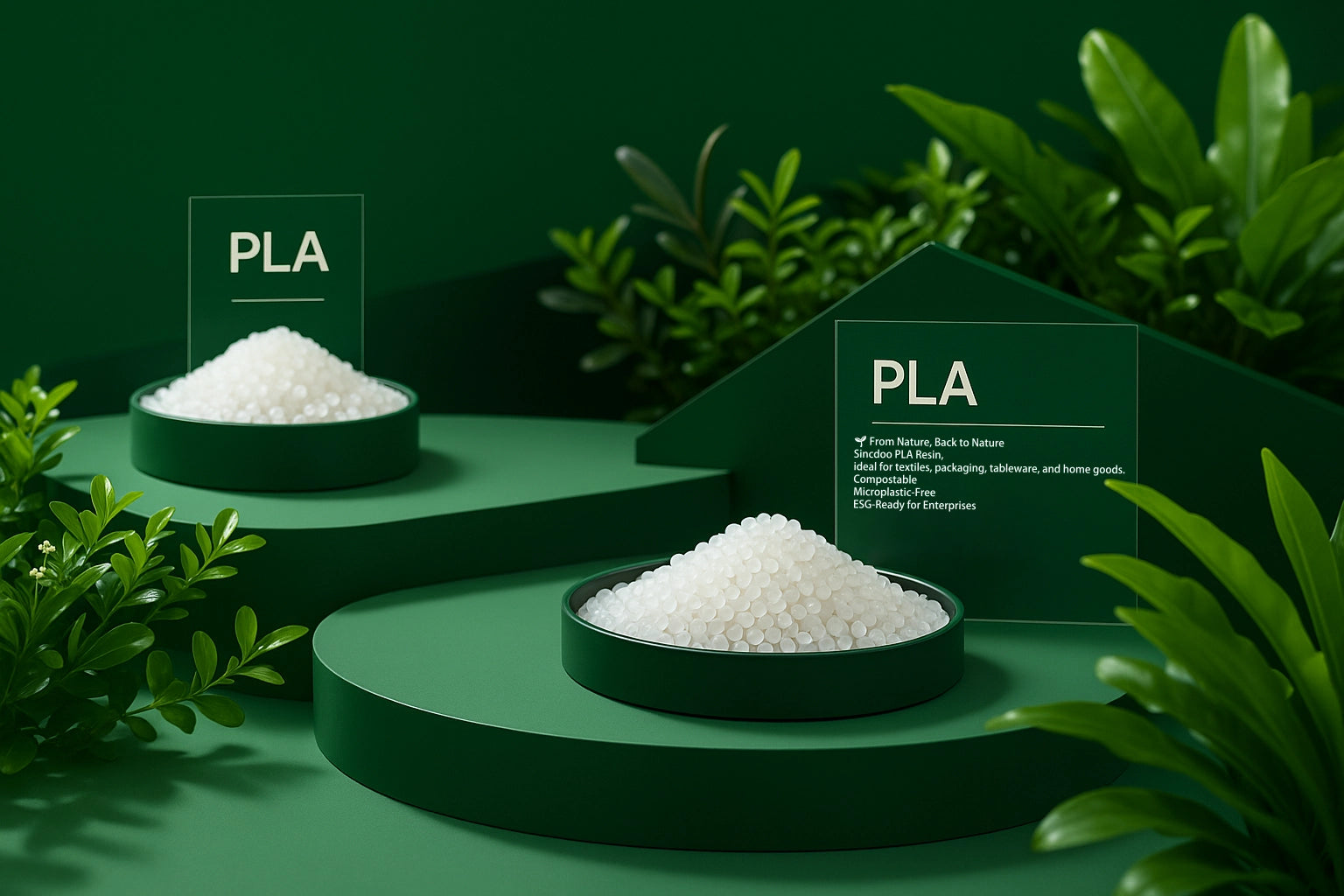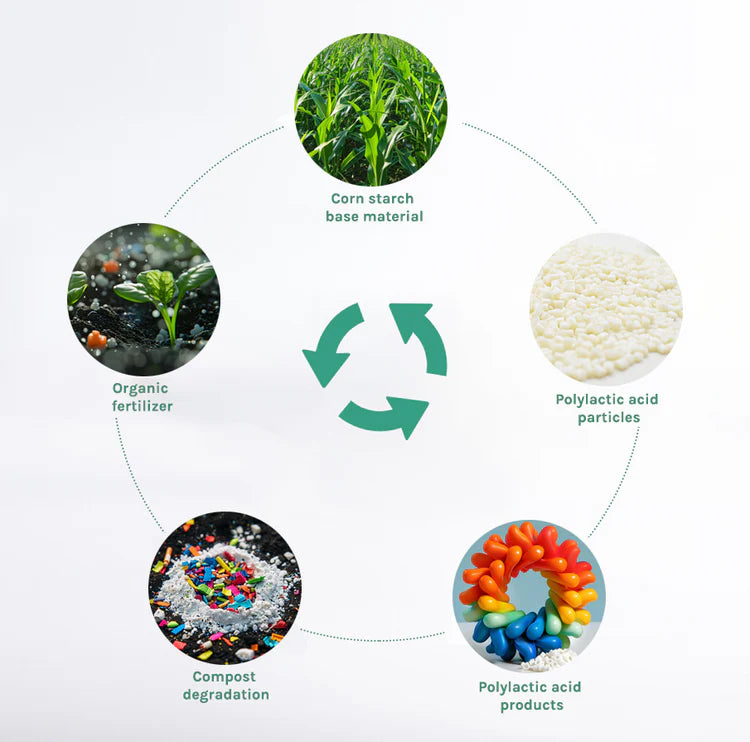
SincdooのPLAについて
PLAバイオプラスチックは、より健康な地球のために、より環境に優しく持続可能な材料を開発する上での前進を示しています。
PLA は効果的な材料ソリューションを提供します。
環境への優しさ、再生可能な資源、多様な用途を通じて、環境汚染の削減と持続可能な発展の推進に貢献します。
Sincdoo Biotech Co., Ltd. はZBグループの子会社で、ポリ乳酸(PLA)製品の研究と応用を専門としています。ZBグループは中国の大手アパレル製造会社で、スーツ、スポーツウェア、カジュアルウェア、アウターウェア、コート、下着、子供服、ホームテキスタイルなど、さまざまな分野の数多くの有名ブランドにOEMサービスを提供しています。さらに、ZBグループは特定の用途に特化した特殊生地も開発しています。ZBグループの子会社として、Sincdooは持続可能で生分解性のある製品の開発と応用に取り組んでいます。ZBグループの強力なデザインと供給能力を活用し、衣料用PLA繊維、PLA日用品、PLA医療用品の分野で革新的なソリューションと高品質の製品を提供しています。
原材料の調達:
市場に出回っているほとんどの生分解性材料は主要作物から派生していますが、Sincdooはより高品質で責任あるPLA用原材料を選定することに専念しています。われわれは、食糧供給に最小限の影響を与える原材料の調達を優先しており、これにはわら、サトウキビ、および少量の遺伝子組み換えトウモロコシが含まれます。これらはPLAを生産するための発酵に使用されます。これらの材料は通常、農業副産物または高収量作物で、世界の食料供給に大きな影響を与えません。さらに、発酵の副産物は他の製品の生産に使用することができます。この原材料調達戦略は、食料資源の競争を減少させるだけでなく、持続可能な開発の原則にも従い、環境保護と資源効率を促進します。Sincdooは、PLA製品の普及を促進しながら、世界の食糧安全と生態バランスに貢献することを目指しています。
技術革新と研究開発能力:
改良PLA顆粒製品:国際的に有名なPLA樹脂会社であるNatureWorks、Total Energies、Haizheng Bio、Fengyuanと協力し、特定の製品特性に基づいて異なる用途向けに改良PLA原材料をカスタマイズしています。
PLA繊維:短繊維と長繊維の両方を提供しており、生産ラインのアップグレードと織り技術の改善を通じて、高品質で多機能性のある生地を生産しています。100%PLA生地を提供し、顧客の要望に応じて、異なる使用環境に適した混紡生地も提供しています。例えば、ポリエステル繊維をPLA繊維に置き換えることで、石油ベースの製品の使用を大幅に削減しています。PLAとウールの混紡生地は安定した性能を確保しながら、綿と石油ベースの材料の使用を避け、使用するウールの量を減らすことで、最終的に動物福祉と環境保護を改善します。さらに、Sincdooは、さまざまな地域の顧客の需要に応じて、有機綿とRWS認証ウールから作られた混紡生地も提供しています。PLA生地と完成した衣類製品の生産に関するOEMソリューションで顧客をサポートしています。
PLA日用品: 日常必需品(ナイフ、フォーク、スプーン、カップなど)や3Dプリント材料を含むカスタマイズされたPLA製品を提供しており、コーヒーかすや米ぬかを加えることで独特の外観を作り出し、環境効果を高めることができます。
PLA医療分野: 病院向けの使い捨てPLA製品、たとえば医療シーツや白衣を提供しています。
自動車および建築材料: PLA材料を取り入れたさまざまなエコフレンドリー製品を開発しており、環境汚染を最小限に抑え、関連企業のカーボン排出を削減することを目指しています。
Sincdooの認証とチーム: DIN、TÜV、BPIなど、さまざまな認証を提供しています。Sincdooには、専門的な研究開発およびデザインチームがあり、著名な研究機関や大学と協力して高品質の製品を共同で開発しています。デザイナーは世界的に認められたアパレル会社出身であり、顧客とのパートナーシップにおいてカスタマイズされた高品質の製品開発ソリューションを提供する能力があります。
SincdooのPLAリサイクルソリューション: 地域の政策の違いにより、すべての地域で生物的な堆肥化と分解が行われるわけではありません。そのため、いくつかのPLAリサイクルソリューションを提供しています:
堆肥化: 堆肥化施設がある地域では、顧客は直接PLA製品を堆肥化して分解することができます。
リサイクルと再利用: 中国のリサイクラーと協力してPLA製品をリサイクルし、それを粉砕して内装および外装装飾に使用される床材に押し出します。
焼却: 電力不足の地域では、PLA製品は完全に燃焼して水と二酸化炭素を生成し、化学製品に比べて環境汚染を大幅に減少させます。
酵素分解: SincdooはXIKe Enzymeと提携して酵素調整剤を開発し、PLAの分解を加速し、生分解性分野でのPLAの利点をさらに示すことを目指しています。
*研究により、自然環境でゆっくりと分解するPLAでも、微小プラスチックの危険は生じないことが示されています。
BusinessWireからの新しいメタスタディのハイライト:加水分解が環境中での持続性PLAマイクロプラスチックの形成を防ぐ
-
環境への優しさ
PLA は生分解性があり、工業用コンポスト施設で水と二酸化炭素に分解され、環境への影響を大幅に減らします。従来の石油由来プラスチックと比べ、PLA の製造と分解は温室効果ガスの排出量が少なく、気候変動の緩和に寄与します。さらに、PLA の分解過程では有害なマイクロプラスチックが生成されず、水域や土壌環境の保護に重要です。
-
再生可能な資源
PLAは、トウモロコシ澱粉、サトウキビ、その他の作物などの再生可能な資源から作られています。これは、有限な化石燃料資源から生産される従来のプラスチックとは対照的です。再生可能な資源を利用することは、化石燃料への依存を減らすだけでなく、持続可能な農業を促進し、農業副産物に新しい価値を創造することにもつながります。
-
用途の多様性
PLAの優れた物理的および化学的特性により、包装材料、使い捨て食器、繊維、医療用品、3Dプリンティング材料など、さまざまな分野で広く使用されています。この多用途性により、PLAは異なる業界のエコフレンドリーな材料の需要に応える高度に柔軟な材料となっています。PLAの多様な用途は、環境の持続可能性を促進し、グリーン経済の成長を支援する上での大きな可能性を示しています。


ポリ乳酸(PLA)の持続可能なライフサイクル
ポリ乳酸(PLA)は、完全な循環型ライフサイクルを実現する革新的な持続可能素材です。PLAは藁(わら)、コーンスターチ、サトウキビなどの再生可能資源から作られ、多様な製品へと加工されます。使用後の製品はコンポスト(堆肥化)によって自然に分解され、有機肥料、水、二酸化炭素へと戻ります。この環境に優しいサイクルにより、廃棄物を削減し、環境保護に貢献し、よりグリーンで持続可能な未来を実現します。
ポリ乳酸(PLA)に関するよくある質問
なぜ PLA は環境に優しいと考えられているのですか?
PLA はトウモロコシデンプンやサトウキビなどの再生可能資源から作られており、これらの資源は成長過程で CO2 を吸収し、温室効果ガスの排出を削減します。さらに、PLA は適切な条件下で完全に生分解され、長期的な環境汚染を減少させます。
PLA が環境中に誤って廃棄された場合、健康や環境への影響は何ですか?
従来のプラスチックと比べ、PLA は生分解性を持つため環境中に長く残存してマイクロプラスチックを生成することがなく、環境や人体への潜在的な害を低減します。
PLA の生分解性はどのように実現されますか?
PLA の生分解性は、産業用コンポスト環境における高温多湿条件下で特定の分子鎖が分解され、最終的に二酸化炭素と水に分解されることで実現されます。これには特定のコンポスト設備が必要です。
PLA の応用における利点は何ですか?
PLA の利点は、その多様性とカスタマイズ性にあります。包装材料、使い捨て食器、衣料品、耐久消費財、医療用製品、さらには自動車の内装製品などの製造に使用できます。また、添加剤を加えることで耐熱性を高めたり、生分解速度を調整したりでき、さまざまな分野のニーズに対応可能です。
PLA は他のバイオプラスチックとどう違うのですか?
他のバイオプラスチックと比較して、PLA は一般的に生分解性、原料供給源、生産過程における環境影響の面で優れています。PLA の原料は主に農作物であり、化石燃料への依存を減らす点で明確な利点があります。
従来のプラスチックと比較して、ポリ乳酸(PLA)製品を使用することの安全性と健康面での利点は何ですか?
PLA 製品は、特に食品包装や容器、乳幼児向け製品において、安全性と健康の面でいくつかの大きな利点を提供します:
1. 有害物質を放出しない:PLA は天然の再生可能資源から作られており、人体に悪影響を与えるビスフェノールA(BPA)やその他の有害化学物質を含みません。対照的に、一部の従来プラスチックは食品との接触や加熱時に有害物質を放出することがあります。
2. 生体適合性:PLA はバイオベースであるため人体により適しており、生分解性縫合糸や薬物送達システムなど医療分野で広く使用されています。これは PLA が人体に対して低い毒性リスクを持つと考えられていることを示しています。
3. 長期曝露リスクの低減:PLA は生分解されるため、使用することで環境中のマイクロプラスチックの蓄積を減らし、食物連鎖を通じた間接的な曝露を軽減します。マイクロプラスチックへの長期曝露は健康に悪影響を及ぼす可能性があると考えられています。特に乳児用玩具では、乳児のかみ癖によるプラスチック摂取を防ぎ、体への害を避けられます。
4. より安全な廃棄物処理:PLA 製品の生分解性は、適切な処理条件下で完全に分解できることを意味し、廃棄物処理中に有害な化学物質が放出されるリスクを低減します。
ポリ乳酸(PLA)製品に関する一般的な質問
Sincdoo ポリ乳酸(PLA)繊維の応用シナリオ
Sincdoo ポリ乳酸(PLA)繊維は、環境に優しく健康志向の素材として、単なる中綿材にとどまらず、繊維・アパレル産業にまで幅広く応用されています。中綿材としては、従来の合成中綿の理想的な代替品となり、製品の健全性と持続可能性を高め、ベビー用おもちゃやソファなどの充填材料に適しています。衣料分野では、PLA 繊維は肌に優しい・抗菌性・環境安全・無毒性・防汚性・撥水性・軽量・快適といった特有の利点により際立っています。これらの特性は、健康志向かつ環境に配慮した衣料を求める現代の消費者ニーズを満たすだけでなく、衣料産業をより持続可能な発展へと導きます。
Sincdoo 耐久性ポリ乳酸(PLA)製品の応用シナリオと製品優位性
食器:Sincdoo の PLA 食器は、環境に優しく生分解性を持つだけでなく、優れた耐熱性と強度を備えているため、使い捨ておよび再利用可能な食器サービスに適しています。また、乳幼児用の食器分野にも応用でき、従来のプラスチック製品の多くを置き換えることが可能です。
子供用硬質玩具:PLA 材料の無毒性は、子供用玩具の製造に理想的であり、安全性を確保すると同時に、日常的な使用に耐えうる耐久性と強度を提供します。
化粧品パッケージ:化粧品パッケージ分野において、PLA は環境に優しい包装ソリューションを提供するだけでなく、優れた外観とカスタマイズ性によりブランド競争力を高め、ブランド価値向上の新たな可能性を切り拓きます。
3D プリント材料:PLA は 3D プリント用材料として、環境への優しさ、プリンター適合性、美観、機械的特性、安全性、コスト効率の高さにより、愛好家や専門家の間で広く評価されています。
Sincdoo の耐久性 PLA 製品は、環境に優しく健康的で高品質な素材に対する市場の需要を満たすだけでなく、企業が新しい市場機会を探求し、ブランド価値を高めるための強力な支援を提供します。
医療用品分野におけるポリ乳酸(PLA)の応用
医療用品分野における PLA の応用は、生体適合性と生分解性を持つ素材としての独自の利点を示しています。具体的には、吸収性縫合糸、薬物送達システム、ステントやインプラント、組織工学、3D プリントによるカスタム医療機器、マスク、使い捨て医療パッドなどがあります。PLA が医療用品で広く使われているのは、その生分解性や生体適合性だけでなく、カスタマイズの可能性があるためであり、患者により個別化された効果的な治療選択肢を提供できます。これらの応用は、医療分野における持続可能な発展とイノベーションを推進するうえで PLA が重要な役割を果たしていることを示しています。
自動車内装におけるポリ乳酸(PLA)の応用
自動車内装アクセサリーにおける PLA の利用は、持続可能で環境に優しい自動車製造への大きな一歩を示しています。当社の現行 PLA 製品には、長期間の保護を目的とした耐久性のあるフロアマット、快適性を高めるための人間工学に基づいたヘッドレスト、多用途で便利なスマートフォンホルダーなどがあります。これらの製品は、PLA の多用途性と耐久性を示すだけでなく、自動車産業における環境負荷低減への取り組みを体現しています。
ポリ乳酸(PLA)のリサイクル
産業用コンポスト:PLA は生分解性を持ちますが、効果的な分解には高温・高湿度の特定の産業用コンポスト施設が必要です。この方法により PLA は完全に水と二酸化炭素に分解されます。
化学リサイクル:化学的リサイクルプロセスにより、PLA は元のモノマーや他の有用な化学物質に分解され、それらを再び重合反応に利用して新しい PLA 製品を作ることができます。
機械的リサイクル:PET など従来のプラスチックほど一般的ではありませんが、PLA にも機械的リサイクルを適用できます。これは PLA 製品を物理的に粉砕して小さな粒子にし、それを洗浄・溶融・再加工して新しい製品にする方法です。
エネルギー回収:PLA は有機材料から作られているため、焼却してエネルギーを回収できます。これは最も環境に優しいリサイクル方法ではありませんが、他のリサイクル手段がない場合には埋立処分の代わりにエネルギーへ転換することが可能です。
